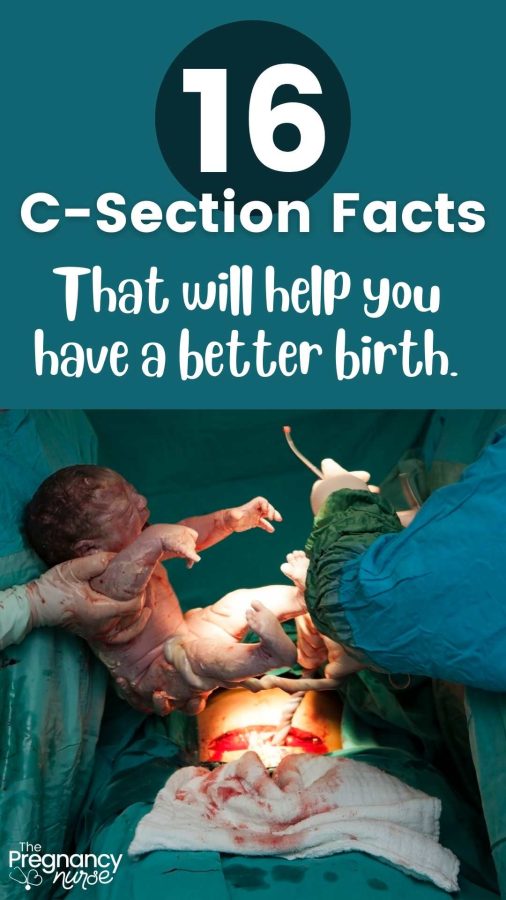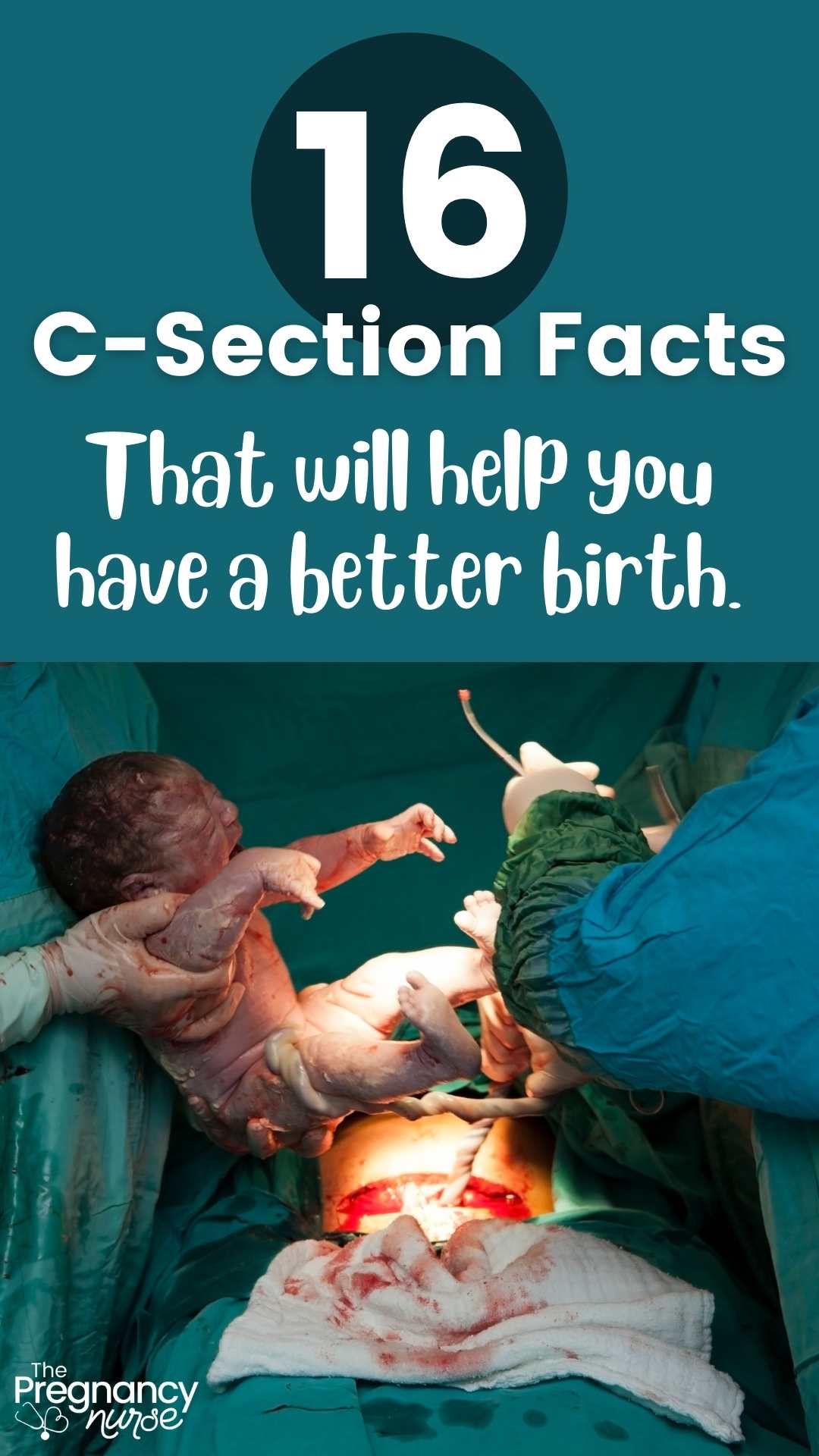There’s a lot of information out there about c-sections – some good, some bad. In this blog post, we’ll give you the facts about c-sections so you can make an informed decision about whether or not to have one. We’ll dispel some myths and talk about the pros and cons of c-sections. So, if you’re pregnant and considering a c-section, keep reading!

First off, I want to remind you to be sure to take cesarean advice from someone who’s seen a lot (and a lot of recoveries). This can be villianized very quickly online — and it doesn’t need to be that way.
If there’s a chance of a c-section in your future — I totally recommend getting a birth class that covers it from beginning to end, so you know what to expect (and also prepares your partner). The Online Prenatal Class for Couples has an entire chapter on Cesarean Birth that so many patients absolutely love. It only takes a few hours, so you can get started today!
At the very least — grab my cesarean prep pack:
Ok, let’s jump in:
C-section Facts
1. They prefer to do a spinal over general anesthesia
A lot of people who are planning on a cesarean section want to be “put to sleep” and not be awake during the surgery.
However, they much prefer to use spinal anesthesia vs general (which is where they put you to sleep) for a variety of reasons, but the main ones are:
- Better, longer pain relief
- Safer for baby (some of the general anesthesia may get to the baby)
- Less risks involved with spinal anesthesia
I have a whole post on my sister site on c-section anesthesia that might interest you.
Want to know more about pain mangement — check out these posts:
- Why Labor Pain Can Feel So Different For Each Person
- 4 Things to Know About Birth Pains
- Do You Need a Birth Class if You Plan to Get an Epidural
- Epidurals During Pregnancy & Labor
2. They Make Sure You’re Numb First
Before the surgery is started they almost always check to make sure you are numb. The only times they wouldn’t is if baby is dying and they believe those few seconds can mean a life-long difference.
They do this by pinching your skin with surgical instruments. They may or may not ask you if you feel anything when they do it.
This doesn’t prevent you from feeling pushing and pulling during the procedure. Sometimes people think they aren’t numb as they feel the tugging when the baby comes out, but that type of feeling is very normal.
We chat about all this in my recent podcast on labor supplies:
3. You get a catheter
Catheters are part of a cesarean section. The good news is that most doctors/facilities put them in once you’re nice and numb with the spinal, so you don’t feel anything.
Check out my post on foley catheters for more information on them (plus a video on how they are inserted).
4. The room is cold
The rooms are kept fairly cold for surgery… for a few reason:
- Less bacterial growth at lower temperatures (humidity is important in those rooms as well).
- The doctors have several layers on during the surgery and we don’t need them sweating into your incision.
- When the surgical lights are turned on it usually heats up
Just don’t be surprised that it is cold back there. Be sure to ask for a warm blanket if you are cold. They should be able to get you one.
Pro Tip: They can also sometimes give you warm IV fluids if you’re really cold and that can help warm up your body.
5. There is a LOT of counting
Before your surgery the staff is required to count every sponge, every instrument, every needle etc.
This is so we can count them after (and during) the surgery to make sure nothing is left behind — so the counting is very normal and important.
Pro Tip: While you can have some say in your surgery it is also really important that the staff does things the same way each time to help keep you safe. Counting is one of those VERY important things.
6. They should still do delayed cord clamping
Delayed cord clamping is now a standard of care in both vaginal and cesarean birth. They will keep the baby on the sterile field and dry them off for 30-60 seconds before they cut the cord.
However, if baby is having an issues they will clamp it earlier and take baby to the nursery.
Babies born cesarean do have some higher risks during their transition period to air, so most often a pediatrician or a neonatologist will be in the room for the baby’s delivery (and then leave once baby is OK).
7. You may feel a lot of pressure right before baby comes out
The don’t cut the area where the baby comes out very large (see #11) due to a variety of reasons, but one of the main ones is it helps squeeze out baby’s lungs as it comes through that small opening.
However, to get baby through that smaller opening the assisting doctor often applies a lot of pressure on the top of your uterus to get baby out. It can be hard to breathe sometimes during this time.
Hopefully anesthesia will warn you that it is coming so you’re aware it is all normal (a lot of people worry their spinal is wearing off, but that isn’t the case at all).
8. Baby can stay in the room with you
It depends on your facility, but many let baby (and your partner) stay in the room with you after birth (as long as everything is going OK). That means you get to hold/see baby while they are finishing up the surgery.
During this time you can attempt skin to skin (or dad can). Some moms may even try to breastfeed (depends on anesthesia I find). However, many find that they are happiest looking at the baby as dad holds it. You are still having major surgery — so make sure you are catering to your own needs rather than what you think you “should” do during this time.

9. You go to a PACU after delivery
After delivery you may go to a different room. It is important that as the spinal anesthesia (or general) is wearing off that we monitor your heart rhythm, oxygen status and any bleeding.
Your nurse will also likely be close for at least the first hour or two because of your risk for problems. She will be monitoring a lot of things during this time (and also doing a lot of charting).
10. There are lots of ways to deal with your pain
A lot of times we think just about pain medication after a surgery but there are a LOT of ways you can deal with your pain (without using narcotics), like:
- Chewing gum to help your bowels move
- Using simethicone to handle your gas (which can be painful)
- Using a binder to help your uterus not “wobble” as much
- Essential oils can sometimes help as well
We are finding that narcotics use can have a lot of negative side effects — so, we are trying to use them as little as possible.
It is always a fine line between trying to make patients comfortable enough to move and heal vs traveling the line of addiction to them. So, we’re trying to be inventive in that process.
11. Your incision may be open to the air
You may plan on the incision being covered with a bandage, but many providers leave it “open to air” meaning you can see/feel it right after birth.
However, some do cover it – just depends.
Most often your incision is closed by a few ways:
- Staples (these aren’t as gross as they sound, and they take them out most often before you go home)
- Stitches — these should likely dissolve on their own.
- Dermabond — this is like medical super glue that can close an incision
- Steri Strips — These look like paper tape that cover the incision. The edges will slowly pull up until it falls off (feel free to cut off the end that has pulled up, just be careful to not cut yourself).
12. Your scar isn’t very big
Your scar will likely be in the natural fold between your belly and your pelvis. That means it’s mostly hidden and can be hidden when wearing a bikini as well.
It also isn’t as big as you imagine. Just 4-6 inches.
13. The whole thing takes about an hour.
From when you get in the room, til’ you’re wheeled out NORMALLY takes just over an hour. There are several things that could delay it to closer to 90 minutes:
- Difficulty placing anesthesia
- Any issues with supplies/staffing
- Any doctor being late
- Previous caesarean sections often take longer due to scar tissue.
Looking to get prepare for your birth? I have some easy options for you!
~~~~~~~~
– Worried you’re missing something? Grab my pregnancy planner so you don’t miss a thing!
– Thinking about an induction? Grab Inductions Made Easy to feel prepared in just 20 minutes!
– Wondering how to get that baby OUT? Grab Going Into Labor Made Easy so you know how to (and not to) do it!
– Postpartum got you anxious? Check out Postpartum Care Made Easy so you can stay SAFE even when all your attention is on that little on.
🚨 AND if ALL OF IT has got you on edge The Online Prenatal Class for Couples is perfect for you — You’ll feel so ready before you even know it!
~~~~~~~~
No matter WHERE you are at in your pregnancy journey, we have resources that can help!
14. We will still push on your belly afterwards
A lot of you may have heard how we push on your baby once you have your baby.
This is to make sure that your uterus is contracting back down on itself and you’re not bleeding.
Honestly, it’s EXTRA important with a cesarean (also because you might not feel a gush of blood due to anesthesia) — so, even though you’ve just had surgery we will push down a bit on your uterus to make sure it feels firm.
It sucks, and we’re sorry about it. But it’s quick — and important.
16. You’ll get up to walk in a few hours
Depending on your hospital, and how the anesthesia wears off, you may be encouraged to get up and walk 4-12 hours after birth. It seems VERY fast to a lot of people, but I can guarantee that the more you walk the better you’re going to feel. Getting your body moving is healing (it just doesn’t feel like that at first).
Pro Tip: This is a good time to get a pain pill on board in advance.
15. It is still birth.
I don’t know who ‘s pretending this isn’t birth, but it totally is. It’s amazing and can be wonderful as well.
Don’t let someone tell you that a caesarean can’t be as magical as a vaginal birth, because it ABSOLUTELY can be. Just go into it informed on what can/will/could happen and I think you’ll have a great time.
And yes, I said informed — so, please do take The Online Pranatal Class for Couples so you really can have that great birth you’re hoping for. Whether it’s vaginal OR cesarean.
Want to do a vibe check before diving into the whole thing with me? — check out my free labor pro tips. It’s your first step toward getting in the driver’s seat of your birth.











 Brazilian Waxing During My Third Trimester of Pregnancy — Is it OK?
Brazilian Waxing During My Third Trimester of Pregnancy — Is it OK?
